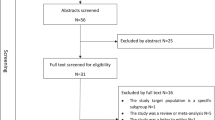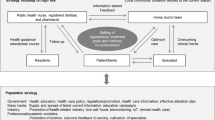Abstract
Clinic physicians' awareness of the Japanese hypertension guideline (JSH 2000) and compliance with its recommendations were assessed to derive policy implications for effective blood pressure control. Data were obtained from two postal questionnaire surveys conducted in 2000 and 2004, and subjects were 896 and 1425 clinic physicians, respectively, who were engaged in general internal medicine. Recognition rates of JSH 2000 were 63.1% (n=822) before its announcement in 2000 and 94.4% (n=1400) in 2004. Rates of access, familiarity and utilisation of JSH 2000 were 87.0, 81.6 and 68.9%, respectively (n=1400) in 2004. As for major management strategies for low-risk hypertension: in 2000, for patients with 140–149/90–94 mmHg, 81.5% of 812 respondents performed lifestyle modification, and 11.2% prescribed medicines, whereas for patients with 150–159/95–99 mmHg, 71.7% of 807 respondents prescribed medicines, and 24.3% conducted lifestyle modification; in 2004, 90.0% of 1384 respondents conducted lifestyle modification, 22.6% prescribed medicines, 2.5% referred patients to other facilities, and 6.4% did nothing. In 2004, 68.9% of 1388 respondents agreed with the new definition of hypertension, whereas 17.1% preferred 160/95 mmHg. Respondents' age (P<0.05) and a percentage of hypertensives in daily patient load (P<0.0005) significantly associated with the choice of the old criteria. In conclusion, JSH 2000 achieved a substantial improvement in clinic physicians' awareness and their compliance to its recommendations on low-risk hypertension management. One of the strategies for further enhancement in their compliance with JSH 2004 would be its dissemination to those who are old and/or do not see hypertensive patients so frequently.
This is a preview of subscription content, access via your institution
Access options
Subscribe to this journal
Receive 12 digital issues and online access to articles
$119.00 per year
only $9.92 per issue
Buy this article
- Purchase on Springer Link
- Instant access to full article PDF
Prices may be subject to local taxes which are calculated during checkout
Similar content being viewed by others
References
Cuspidi C, Michev I, Meani S, Severgnini B, Sala C, Salerno M et al. Awareness of hypertension guidelines in primary care: results of a regionwide survey in Italy. J Hum Hypertens 2003; 11: 541–547.
Dickerson JEC, Garratt CJ, Brown MJ . Management of hypertension in general practice: agreements with and variations from the British Hypertension Society guidelines. J Hum Hypertens 1995; 9: 835–839.
Hagemeister J, Schneider CA, Barabas S, Schadt R, Wassmer G, Mager G et al. Hypertension guidelines and their limitations – the impact of clinic physicians' compliance as evaluated by guideline awareness. J Hypertens 2001; 19: 2079–2086.
Japanese Society of Hypertension Guidelines Subcommittee for the Management of Hypertension. Guidelines for the management of hypertension for general practitioners. Hypertens Res 2001; 24: 613–634.
Japanese Society of Hypertension Guidelines Subcommittee for the Management of Hypertension. Guidelines for the Management of Hypertension (JSH 2004). Japanese Society of Hypertension: Tokyo, 2004 (in Japanese).
Saito I, Kawabe H, Tsujioka M, Hirose H, Shibata H . Trends in pharmacologic management of hypertension in Japan: one year after the publication of the JSH 2000 guidelines. Hypertens Res 2002; 25: 175–178.
Goto Y, Kawakami T, Tada H, Sugawara M, Kawanabe K, Shiota Y et al. Kouketsuatsu no tiryo ni kansuru jittaichousakenkyuu. J Japan Phys Assoc 2003; 18: 181–192 (in Japanese).
Hyman DJ, Pavlik VN . Self-reported hypertension treatment practices among primary care physicians: blood pressure thresholds, drug choices, and the role of guidelines and evidence-based medicine. Arch Intern Med 2000; 160: 2281–2286.
Acknowledgements
This study was financially supported with a grant in 2000 from the Ministry of Health and Welfare for the Research on Disease Management of Hypertension and Relevant Diseases (H12-iryo-002, principal investigator: Dr Toshihiko Hasegawa) and with another grant in 2004 from the Ministry of Health, Labor and Welfare for the Research on Evaluation of Clinical Guidelines (H14-iryo-035, principal investigator: Professor Tomonori Hasegawa).
Author information
Authors and Affiliations
Corresponding author
Rights and permissions
About this article
Cite this article
Ikeda, N., Hasegawa, T., Hasegawa, T. et al. Awareness of the Japanese Society of Hypertension Guidelines for the Management of Hypertension (JSH 2000) and compliance to its recommendations: surveys in 2000 and 2004. J Hum Hypertens 20, 263–266 (2006). https://doi.org/10.1038/sj.jhh.1001977
Received:
Accepted:
Published:
Issue Date:
DOI: https://doi.org/10.1038/sj.jhh.1001977
Keywords
This article is cited by
-
Epidemiology and control of hypertension in Japan: a comparison with Western countries
Journal of Human Hypertension (2021)
-
Relationship of Annual Health Checkups with the Subject’s Subsequent Behavior of Cardiovascular Risk Management in a Real-World Setting in Japan: A Retrospective Cohort Study on Changes in Antihypertensive Drug Prescription and Blood Pressure from 2015 to 2017
Drugs - Real World Outcomes (2021)
-
Awareness of the Japanese Society of Hypertension Guidelines for the Management of Hypertension and their use in clinical practices: 2009 survey results
Hypertension Research (2015)
-
The impact of a change in hypertension management guidelines on diuretic use in Japan: trends in antihypertensive drug prescriptions from 2005 to 2011
Hypertension Research (2013)
-
Practice and awareness of physicians regarding home blood pressure measurement in Japan
Hypertension Research (2010)



